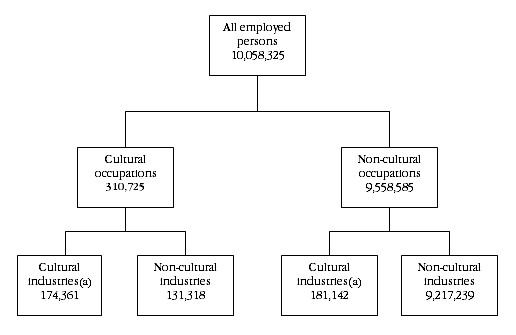Overview
This chapter presents information about persons employed in a cultural occupation (as classified by the Australian and New Zealand Standard Classification of Occupations (ANZSCO) 2006 (cat. no. 1220.0)) or a cultural industry (as classified by the Australian and New Zealand Standard Industrial Classification (ANZSIC) 2006 (Revision 1.0) (cat. no. 1292.0)) for their main job.
The 2011 Census found that 3.1% of employed persons (310,725 persons) in Australia worked in a cultural occupation. The Census also found that some 3.6% of employed people (358,162 persons) worked in a cultural industry. (Table 3)
The following diagram summarises ways in which people can be 'culturally' employed. They can either work in a cultural occupation in a cultural industry; in a cultural occupation but not in a cultural industry; or in a non-cultural occupation but in a cultural industry. In 2011, a large proportion of the people who were employed in a cultural occupation worked in a non-cultural industry (42.3% or 131,318 persons). A librarian employed in a university is an example of a cultural occupation within a non-cultural industry. (Table 3)

(a) Cultural industries excludes not stated and inadequately described.
Around half of the people employed in a cultural industry worked in a non-cultural occupation (50.6% or 181,142 persons). A cleaner employed in an art gallery is an example of a non-cultural occupation within a cultural industry. The relationship between the employment in cultural occupations and cultural industries is illustrated by the diagram above. (Table 3)
 Print Page
Print Page
 Print All
Print All